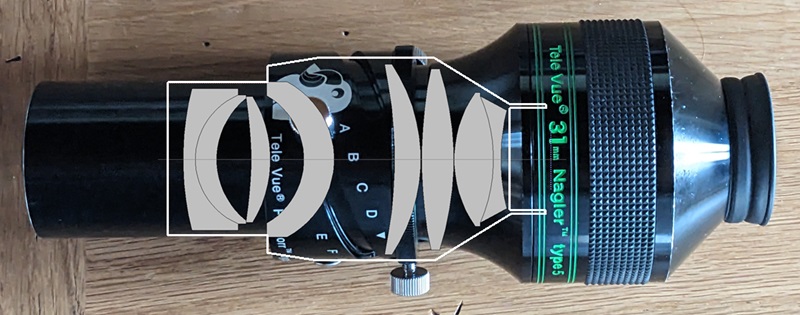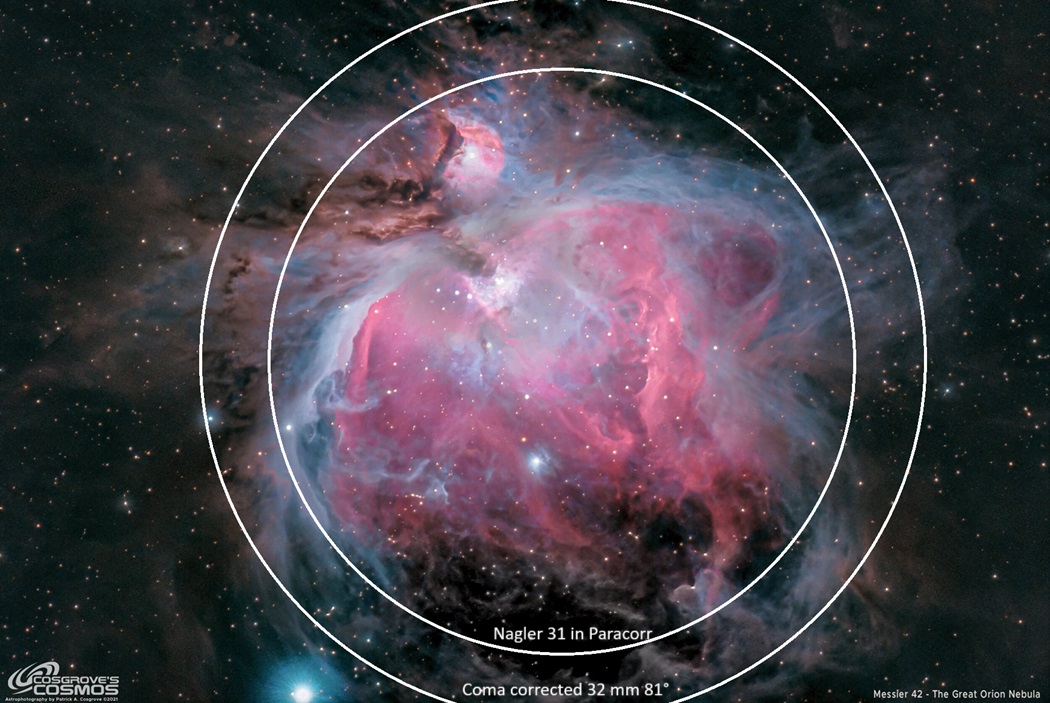|
||||
Coma correcting eyepieces can provide a lighter, cheaper, more convenient solution that can optically outperform a coma corrector plus standard eyepiece. Below some of the drawbacks of using standard eyepieces in a coma corrector that are improved by coma correcting eyepieces. 1. Size and weightPopular coma correctors like the Televue Paracorr 2 and Explore Scientific HR are bulky devices; they are typically about 140 mm long and add around 0.5 kg at the eyepiece. Furthermore, the Paracorr 2 extends 75 mm inside the focuser. The author's 25" f/5 telescope has been optimized for small secondary size (100 mm, giving 16% central obstruction) with a low profile Moonlite focuser mounted as close as possible to the optical axis. The Paracorr 2 then intrudes in the secondary cage and, sadly, prevents me from using a filter slide on this telescope. It's worth emphasizing that well designed coma correcting eyepieces do not have to be bulkier than standard eyepieces!
 2. CostTelevue Paracorr 2 pricing is around $550/€700 in US/EU, Explore Scientific HR around $400/€350 in US/EU, the integrated Feather Touch SIPS adds about $850/€1000 in US/EU. Money that could have been spent on eyepieces! 3. Barlow effect - True Field of ViewThe coma corrector provides a slight Barlow effect which reduces the maximum field of view. The coma corrector limits the widest field of view of the telescope, and for me personally this is one of its biggest drawbacks! Two real examples:
4. Ease of use - FocusingThe Televue Paracorr contains a helical focuser (a.k.a. tunable top) to keep the coma corrector at the right position. When changing the eyepiece, the eyepiece has to be moved at its approximate focuser position with the tunable top. Then you can finetune with the actual focuser of the telescope. While many observers including the author have got used to doing this, it still is a hassle compared to normal focusing, and adds some mechanical flexibility to the optical chain. The Feather Touch SIPS product page explains the advantages of not needing a tunable top: “Once it is set-up, there is no need to fumble with locking screws, turning your flashlight on to check its position, etc. This saves time and hassle. Also, the assembly is more rigid and flexure is greatly reduced. The SIPS Coma Corrector totally eliminates the need to re-adjust/calibrate when switching eyepieces. You will simply adjust the focus knobs of your Feather Touch focuser for viewing. Because of this, the SIPS Coma Corrector will save you valuable observing time, less hassle and ease of use.” Obviously, living without a coma corrector altogether provides the same benefits, and more! 5. VignettingFor eyepieces with a large field stop, the coma corrector can vignette the outer parts because the 2 inch corrector inserts a 48 mm diameter lens quite far from the focal plane. A f/4 cone at 88 mm of the focal point is 22 mm wide, which implies that a 48 mm lens could only provide full illumination to a 26 mm field stop. In practice this is not as bad as it sounds, very often the secondary diagonal mirror will be the limiting factor for the field illumination. Still, the absence of a long coma corrector in front of the actual eyepiece means that a coma correcting eyepiece can better exploit the available 2" focuser diameter - as demonstrated by the 32 mm 81° coma correcting eyepiece which delivers a 45 mm field stop. 6. Focus in-travelComa correctors require some extra focus in-travel, typically 15 mm but sometimes more (the lower the Barlow effect of the coma corrector, the larger the extra focus in-travel will be). This moves the focal plane farther from the main optical axis, requiring a bigger secondary mirror or reducing the fully illuminated field. 7. Number of optical elements - Transmission and scatterThe coma corrector inserts 4 or 5 elements in the optical path, adding to the 6 to 10 elements from premium eyepieces. Every element generates some light loss (glass transmission and surface reflection) and creates additional scatter. SummaryIn short, coma correcting eyepieces can provide a lighter, cheaper, more convenient solution that can optically outperform the combination of a standard eyepiece with a separate coma corrector. | ||||
|
